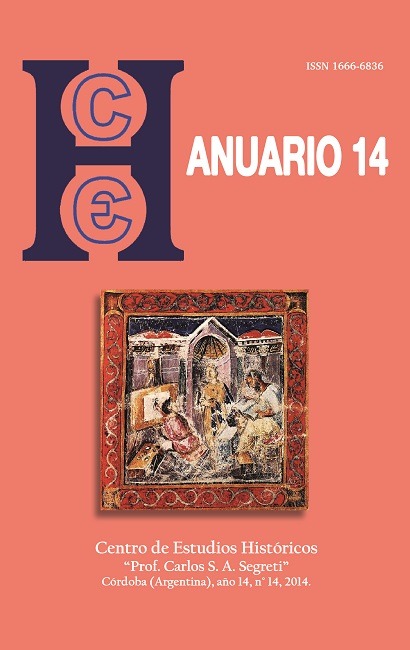Reminiscencias de la muerte y la divulgación del dolor en la estela funeraria de lucius trebius divus
DOI:
https://doi.org/10.52885/2683-9164.v0.n14.22141Palabras clave:
muerte, memoria, dolor y epigrafíaResumen
Recientes estudios han apuntado un continuo crecimiento de análisis sobre la manera en como las personas mueren, tratamiento de los cuerpos, tipos de sepulturas, local de deposición en el sitio, artefactos, construcciones identitarias en sarcófagos y relevos, más allá del paisaje funerario. Al tomar en consideración la relevancia de la representaciones mortuorias en el Mediterráneo romano, analizaremos, en términos históricos, la experiencia social de la muerte, a medida que engloba la forma en cómo los muertos en la sociedad son recordados o, dependiendo de las circunstancias, condenados al olvido. En función de la temática, el acervo documental contempla la estela funeraria de Lucius Trebius Diuus. Por lo tanto, nos debemos concentrar en las dimensiones más particulares y emocionales del recuerdo de los muertos, a medida que el túmulo podría tornarse un espacio de peregrinación y reverencia, una casa o un santuario para los muertos y las asociaciones de los muertos con las divinidades emocionales de sobrevivientes. A partir de ahí, trazaremos reflexiones de la expresión pública del dolor y la inserción de dimensiones más particulares y emocionales en la forma en cómo se recordaba a los muertos en la sociedad romana.
Descargas
Referencias
APPADURAI Arjun,, “Introduction: commodities and the politics of value”, APPADURAI Arjun (comp.), The social life of things, Cambridge, Cambridge University Press, 1986.
ARCE Javier, “Funus Imperatorum: Los Funerales de los Emperadores Romanos”, Madrid, Alianza, 1990.
BERSANI Silvia G., «Epigrafia e storia di Roma », Roma, Carocci, 2014. 41 BIRK, 2011.
BIRK Stine, “Man or woman. Cross-gendering and individuality on third century Roman sarcophagi”, ELSNER Jás y HUSKINSON Janet, (comp.), “Life, death and representation. Some new work on Roman sarcophagi”, New YorkBerlin, Walter de Gruyter Gmbh & Co. KG, 2011.
CICERO M. T., De senectute. Books I-II. Trad. Domenico Lassandro e Giuseppe Micunco. Italian: UTET, 2007.
DIXON S., “Conflict in the Roman family”, RAWSON B. y WEAVER Paul (comp.), “The Roman family in Italy. Status, sentiment, Space”, Oxford, Oxford University Press, 1999.
ECKARDT Hella y WILLIAMS Howard, “Objects without a past? The use of Roman objects in early Anglo-Saxon graves”, WILLIANS Howard, “Archaeologies of remembrance”, New York: KaPP, 2003.
ELIAS Norbert, A solidão dos moribundos. Seguido de envelhecer e morrer. Rio de Janeiro: Zahar, 2001.
FISHWICK Duncan, “The Deification of Claudius”, The Classical Quarterly, Vol. 52, No. 1, 2002.
FUNARI Pedro Paulo A., “A diversidade de concepções sobre a morte e a magia: uma abordagem antropológica”, BUSTAMANTE R. C., R. C. (comp.), “Vida, morte e magia no mundo antigo”, Rio de Janeiro, NEAUERJ, 2008.
GOWING Alain M., “Empire and memory: the representation of the Roman Republic in imperial culture”, Cambridge, Cambridge University Press, 2005.
GRAHAN Emma-Jayne, “Memory and materiality: re-embodying the roman funeral”, HOPE Valerie, y HUSKINSON Janet, Memory and mourning. Studies on roman death, Oxford: OXBOW BOOKS, 2011.
HOPE Valerie, “Contempt and respect. The treatment of the corpse in Ancient Rome”, HOPE Valerie, y MARSHALL Eiream, (comp.), “Death and disease in the Ancient city”, London and New York, Routledge, 2000.
HOPE Valerie,“Remembering to mourn personal mementos of the dead in Ancient Rome”, Valerie HOPE y Janet HUSKINSON, Janet (comp.), Memory and Mourning: Studies on Roman Death,Oxford, Oxbow Books, 2011.
HOPE Valerie, “Remembering Rome. Memory, funerary monuments and the Roman soldier”, WILLIAMS H., “Archaeologies of remembrance. Death and memory in past societies”, New York: Kluwer Academic, 2003.
HULLS Jean-Michel, “Monuments: grief and Consolation in Statius Silvae 33”, HOPE Valerie M. y HUSKINSON Janet , “Memory and mourning. Studies on Roman death”, Oxford, Oxbow Books, 2011.
HUSKINSON Janet, “Constructing childhood on roman funerary memorials”, “Hesperia Supplements”, vol. 41, Italy, 2007.
HUSKINSON Janet, “Looking for culture, identity and power”, HUSKINSON Janet, “Experiencing Rome. Culture, identity and power in the Roman empire”, Canada, Routledge, 2005.
JONES S., “The archaeology of ethnicity: constructing identities in the past and present”, London, Routledge, 1997.
KREITZER Larry, “Apotheosis of the Roman Emperor”, The Biblical Archaeologist, Vol. 53, No. 4, Dec., 1990.
Mendoza LUJÁN Erik, “Espántame, panteón. Los espacios y usos del cuerpomuerto”, Vita Brevis, Año 1, núm. 1, Enero-Junio, 2012.
METCALF Peter, y HUNTINGTON Richard, Celebrations death. The anthropology of mortuary ritual. Cambridge: Cambridge University Press, 2010.
MORIN Edgar, El ser humano y a muerte. Barcelona: Kairós, 2003.
PRICE Simon, “From noble funerals to divine cult: the Consacration of Roman Emperors”, CANNADINE David y PRICE Simon, Simon (comp.), “Rituals of Royalty: Power and Ceremonial in Traditional Societies”, Cambridge, University Press, 1992.
RUSSEL Ben, “The Roman sarcophagus “industry’: a reconsideration”, ELSNER Jás y HUSKINSON Janet (comp.), “Life, death and representation. Some new work on Roman sarcophagi”, New YorkBerlin, Walter de Gruyter Gmbh & Co. KG, 2011.
SALLER Richard P., “Patriarchy, property and death in the Roman family”. Cambridge, Cambridge Studies in Population, Economy and Society in Past Time, 1994.
SARTORI A., Guida alla sezione epigrafica delle raccolte archeologiche di Milano. Milano: Comuni di Milano, 1994.
SCHEID Jonh, Rito e religione dei romani, Bergamo, Sestante Edizioni, 2009.
SMITH C. J., “The Roman Clan. The gens from Ancient ideology to Modern Anthropology”, Cambridge, Cambridge University Press, 2006.
THOMAS Edmund, “Houses of the dead. Columnar sarcophagi as micro-architecture”, ELSNER Jás y HUSKINSON Janet (comp.), “Life, death and representation. Some new work on Roman sarcophagi”, New YorkBerlin, Walter de Gruyter Gmbh & Co. KG, 2011.
WALLACE-HADRILL Andrew, “Rome’s Cultural Revolution”, London, Cambridge, 2008.
WOOLF Greg, “Inventing empire in ancient Rome”, ALCOCK, SUSAN Susan E.; D’ALTROY Terence N.; MORRISON K. D. y SINOPOLI Carla M., “Empires.Perspectives from Archaeology and History”, Cambridge, Cambridge University Press, 2009.
Descargas
Publicado
Número
Sección
Licencia
Aquellos autores/as que tengan publicaciones con esta revista, aceptan los términos siguientes:
- Los autores/as conservarán sus derechos de autor y garantizarán a la revista el derecho de primera publicación de su obra, el cuál estará simultáneamente sujeto a una Licencia de reconocimiento de Creative Commons. Se puede compartir, copiar, distribuir, ejecutar y comunicar públicamente la obra, siempre que: a) se cite la autoría y la fuente original de su publicación (revista, editorial y URL de la obra); b) no se use para fines comerciales; c) no se altere, transforme o genere una obra derivada a partir de esta obra.
- Los autores/as podrán adoptar otros acuerdos de licencia no exclusiva de distribución de la versión de la obra publicada (p. ej.: depositarla en un archivo telemático institucional o publicarla en un volumen monográfico) siempre que se indique la publicación inicial en esta revista.
- Se permite y recomienda a los autores/as difundir su obra a través de Internet (p. ej.: en archivos telemáticos institucionales o en su página web) después del proceso de publicación, lo cual puede producir intercambios interesantes y aumentar las citas de la obra publicada. (Véase El efecto del acceso abierto).









